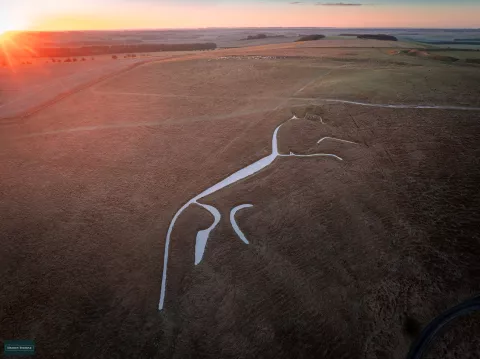The Uffington White Horse is the oldest and most distinctive hill-figure (or geoglyph) of a horse in Britain. We can trace mentions of the White Horse in medieval documents writtent 700 to 1000 years ago, but scientific dating confirmed that it was originally carved during prehistory. This White Horse is therefore far older than any of the other chalk figures that are dotted across the south of England.
Surrounded by the traces of people that came before and after the chalk figure, the White Horse owes its survival to the local communities who have regularly been maintaining it over perhaps a hundred generations. In fact, the Horse could easily disappear if left untouched for a decade or more. No other monument in the country can claim this continuity of attention and commitment irrespective of language, ruler, and religion.
This blog is about the latest (but certainly not the last!) chapter in the White Horse's long history of being treasured, protected, and preserved for future generations. As well as presenting the archaeology, the following posts will set the Horse in its natural, archaeological, and cultural landscape. We will touch on how the area has developed and the changing interpretations of what and why. We will describe our current work which will return the Horse to its more traditional shape and attempt to get a closer understanding of its origins.
An iconic monument in an ancient landscape
The White Horse's ancient origins are not the only reason why it is so well-loved. The chalk figure is located in the parish of Uffington, Oxfordshire. It is 120 metres long and was formed by digging segmented chalk trenches into the upper slopes of the hill, sitting in a spectacular natural landscape on the dramatic scarp of the Wessex chalk Downs. Many natural features combine to create the dramatic setting: the deep plunging valley, the Manger, with its rippling sides; a flat-topped conical hill under the Horse, Dragon Hill; the panoramic view over the Vale to the Corallian Ridge, the Cotwolds and the Thames Valley beyond.
Then there are the archaeological traces of those who came before, as well as after, the Horse: the ancient Ridgeway route, running along the scarp from the hillfort to Wayland’s Smithy, a Neolithic tomb, to the west; Uffington Castle, the Iron Age hillfort above the Horse; a long mound - a Neolithic or early Bronze Age barrow reused as a Roman cemetery millennia later; Bronze Age circular barrows which were reused for burials in the Anglo-Saxon period. The Horse's remarkable, abstract shape with a distinctive ‘beaked’ head resembles images of some horses on Ancient British coins. Antiquity permeates the whole area.
The strong emotive bonds, that this rich and natural landscape evoke in us, were obviously felt as keenly by those past generations that built the Horse, and lived and were buried there. The landscape and its deep history are intertwined with local legends and customs, and tied together by the language of myth from the Germanic blacksmith god to the medieval legend of St George, who is said to have slain the dragon here.
It is incredible that such a fragile and vulnerable image should have been preserved for centuries. It has only been possible thanks to the care of local communities.

The current project
In recent years people in the Vale have noted that the figure of the Horse has become less distinct, almost disappearing from view.
In 2022 archaeologists from Oxford Archaeology carried out a detailed survey of the Horse, using a drone, and compared this with earlier images taken from aerial photographs and surveys. This new survey suggested that the lines of the Hose were shrinking, by as much as 40 percent in recent years.
In 2023, the archaeologists dug narrow trenches across some of the lines of the hill-figure and confirmed the aerial survey results. The Horse was indeed shrinking, as soils and turf colonised its chalk lines.
In 2024 we begin the restoration of the Horse and trenched the topsoil further. In the 1990s we used optically stimulated luminescence dating (OSL) to date soil layers below the Horse and dated it to between 1380 and 210 BC – later Bronze Age or Iron Age. This year we will attempt to retrieve more accurate dates. Our old excavation trenches will be reopened to acquire more dating samples which will be analysed by OSL again – but with over 30 years of scientific development improving the technique.

Meet the project team
The White Horse and the surrounding archaeological features on White Horse Hill are on land belonging to the National Trust. These are protected as Scheduled Ancient Monuments in the Guardianship of English Heritage.
The current project is being undertaken by Oxford Archaeology, directed by Project Manager Mark Dodd, along with Simon Palmer and David Miles. They are working in co-operation with Andy Foley, National Trust Ranger, Adrian Cox, National Trust Archaeologist, and their team of volunteers. Scientific dating is by Oxford Laboratory for Archaeology and the History of Art, led by Jean-Luc Schwenninger.
The work is principally funded by Oxford Archaeology and a generous donation from Ian Godfrey and Lecki Ord, Australian lovers of the Horse.
And with heartfelt thanks to Hedley Thorne for allowing us to use his beautiful photographs of White Horse Hill and its surroundings, and to Anna Dillon for sharing her paintings and connection to this beautiful landscape.
In collaboration with...






